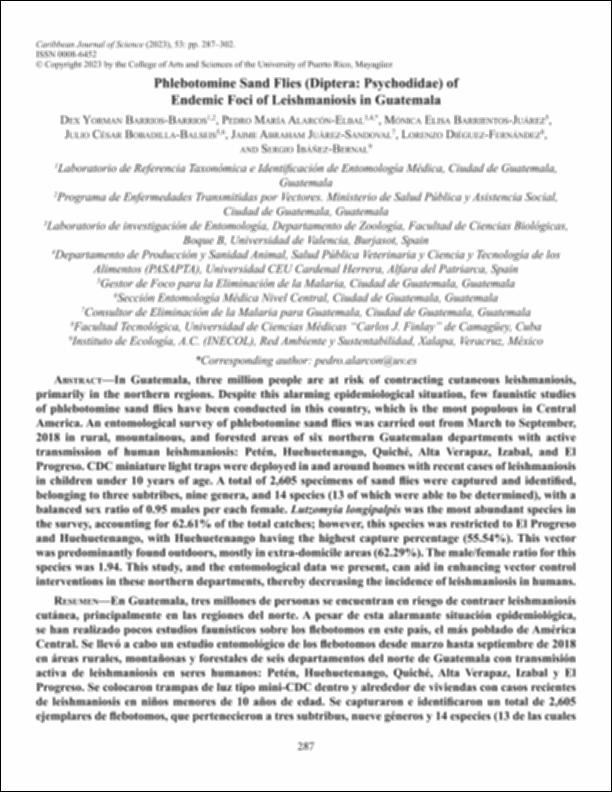Please use this identifier to cite or link to this item:
http://hdl.handle.net/10637/15491Phlebotomine sand flies (Diptera: Psychodidae) of endemic foci of leishmaniosis in Guatemala
| Title: | Phlebotomine sand flies (Diptera: Psychodidae) of endemic foci of leishmaniosis in Guatemala |
| Authors : | Barrios Barrios, Dex Yorman Alarcón Elbal, Pedro María Barrientos Juárez, Mónica Elisa Bobadilla Balseis, Julio César Juárez Sandoval, Jaime Abraham Diéguez Fernández, Lorenzo Ibáñez Bernal, Sergio |
| Keywords: | Leishmaniasis; Zoonosis; Zoonoses; Animales vectores; Animals as carriers of disease; Moscas; Flies; Transmisión de enfermedades; Communicable diseases transmission; Guatemala; Dípteros; Diptera |
| Publisher: | BioOne College of Arts and Sciences of the University of Puerto Rico, Mayagüez |
| Citation: | Barrios-Barrios, D.Y., Alarcón-Elbal, P.M., Barrientos-Juárez, M.E., Bobadilla-Balseis, J.C., Juárez-Sandoval, J.A., Diéguez-Fernández, L. & Ibáñez-Bernal, S. (2023). Phlebotomine sand flies (Diptera: Psychodidae) of endemic foci of leishmaniosis in Guatemala. Caribbean Journal of Science, vol. 53, i. 2 (27 oct.), pp. 287-302. DOI: https://doi.org/10.18475/cjos.v53i2.a11 |
| Abstract: | In Guatemala, three million people are at risk of contracting cutaneous leishmaniosis, primarily in the northern regions. Despite this alarming epidemiological situation, few faunistic studies of phlebotomine sand flies have been conducted in this country, which is the most populous in Central America. An entomological survey of phlebotomine sand flies was carried out from March to September, 2018 in rural, mountainous, and forested areas of six northern Guatemalan departments with active transmission of human leishmaniosis: Petén, Huehuetenango, Quiché, Alta Verapaz, Izabal, and El Progreso. CDC miniature light traps were deployed in and around homes with recent cases of leishmaniosis in children under 10 years of age. A total of 2,605 specimens of sand flies were captured and identified, belonging to three subtribes, nine genera, and 14 species (13 of which were able to be determined), with a balanced sex ratio of 0.95 males per each female. Lutzomyia longipalpis was the most abundant species in the survey, accounting for 62.61% of the total catches; however, this species was restricted to El Progreso and Huehuetenango, with Huehuetenango having the highest capture percentage (55.54%). This vector was predominantly found outdoors, mostly in extra-domicile areas (62.29%). The male/female ratio for this species was 1.94. This study, and the entomological data we present, can aid in enhancing vector control interventions in these northern departments, thereby decreasing the incidence of leishmaniosis in humans. En Guatemala, tres millones de personas se encuentran en riesgo de contraer leishmaniosis cutánea, principalmente en las regiones del norte. A pesar de esta alarmante situación epidemiológica, se han realizado pocos estudios faunísticos sobre los flebotomos en este país, el más poblado de América Central. Se llevó a cabo un estudio entomológico de los flebotomos desde marzo hasta septiembre de 2018 en áreas rurales, montañosas y forestales de seis departamentos del norte de Guatemala con transmisión activa de leishmaniosis en seres humanos: Petén, Huehuetenango, Quiché, Alta Verapaz, Izabal y El Progreso. Se colocaron trampas de luz tipo mini-CDC dentro y alrededor de viviendas con casos recientes de leishmaniosis en niños menores de 10 años de edad. Se capturaron e identificaron un total de 2,605 ejemplares de flebotomos, que pertenecieron a tres subtribus, nueve géneros y 14 especies (13 de las cuales pudieron determinarse), con una proporción de sexos equilibrada de 0.95 machos por cada hembra. La especie más abundante en el estudio fue Lutzomyia longipalpis, que representó el 62.61% del total de capturas; sin embargo, esta especie se limitó a El Progreso y Huehuetenango, siendo Huehuetenango el lugar con el porcentaje de capturas más elevado (55.54%). Este vector se encontró predominantemente en exteriores, sobre todo en el extradomicilio (62.29%). La proporción de machos/hembras para esta especie fue de 1.94. Este estudio y los datos entomológicos que presentamos pueden contribuir a mejorar las intervenciones de control de vectores en estos departamentos del norte, reduciendo así la incidencia de leishmaniosis en seres humanos. |
| Description: | Este recurso está disponible en acceso abierto con la autorización de la revista o editorial. |
| URI: | http://hdl.handle.net/10637/15491 |
| Rights : | http://creativecommons.org/licenses/by-nc-nd/4.0/deed.es |
| ISSN: | 0008-6452 |
| Issue Date: | 27-Oct-2023 |
| Center : | Universidad Cardenal Herrera-CEU |
| Appears in Collections: | Dpto. Producción y Sanidad Animal, Salud Pública Veterinaria y Ciencia y Tecnología de los Alimentos |
Items in DSpace are protected by copyright, with all rights reserved, unless otherwise indicated.


